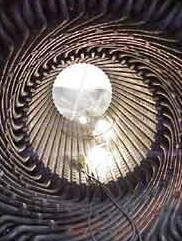
How Do Generators Work?

Generators
are machines that convert mechanical energy into electrical energy. They
operate under the principle of electromagnetic induction. The principles
of electromagnetic induction were discovered by Michael Faraday in 1831.
He discovered that by moving an electric conductor through a magnetic field he
could cause the electric field to push on the electric charges through the
conductor producing a current. It was this discovery
that led to the invention of generating electricity endlessly, thus creating the
electric generator.

Today,
electric generators work on the same basic principals of moving a magnetic field
through a coil of wire or vise versa. Turbines are used to produce the
motion necessary to make generators work. These turbines are attached
to shafts that are connected to giant magnets that are located inside a coil of
wires. As steam passes through the
turbines, it spins these large shafts which in turn spin the attached to magnets
inside the coils of wire inside the generator. Since the magnet is turning,
the coils pass through the magnetic field first in one direction, and then in
the other. This causes the induced current to be an alternating current.
Due to the simple nature of how electric generators work, there is no theoretical limit to how much current can be produced by a generator. For all practical purposes in the real world though, this is not the case. Due to the limits of a generators wiring, magnetic fields, and machinery, there reaches a maximum point of current production. These limits are due to the resistance in the coils of wire, the increased production of heat due to large amounts of current, and the complications caused by stronger magnetic fields.